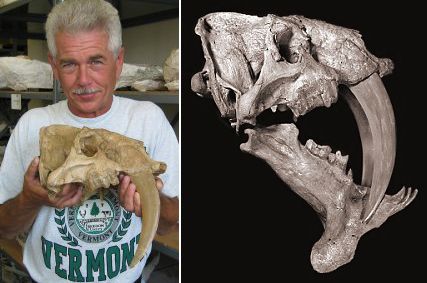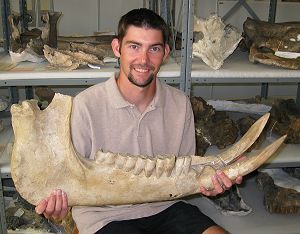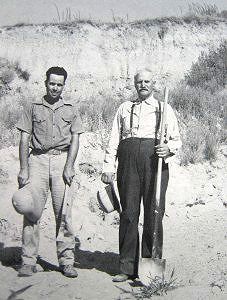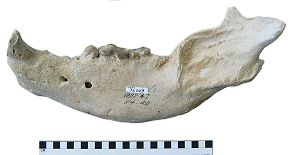
Nebraska County Fossils
Frontier
< Vertebrate Paleontology Home
A virtual journey through the Museum's vertebrate paleontology collection.
Barbourofelis, Barbour's sabre cat
Family: Nimravidae
Geologic age: Late Miocene (Middle Hemphillian), about 7.5 million years old
Year fossil collected: 1947


Barbourofelis was one of the most specialized carnivores to ever roam Nebraska. The eight inch sabre tooth and scissor-like shearing teeth meant that Barbourofelis didn't much bother with chewing...just ripping and slicing...and swallowing! The lower jaw had a flange to protect the protruding upper sabre and efficient "grabbing" teeth (incisors) in the front. So, what did he eat? Anything he wanted!!
Aphelops "kimballensis", Smooth-faced rhino from Kimball
Family: Rhinocerotidae
Geologic age: Late Miocene (Late Hemphillian), about 7.5 million years old
Year fossil collected: 1947
Notes: Type Specimen


Aphelops was one of the largest of the many species of rhinoceros that have lived in Nebraska. Huge tusks in the lower jaw (left) may have been used for defense or for ritual fighting with other members of its species. The tall vault to the back of the skull, modified for the attachment of strong muscles extending from the neck, give the skull the unusual saddle-shape typical of this rhinoceros. "Rhinoceros" means "nose-horn", but not all rhinos had horns. Lack of a horn gave this rhino its name!
Indarctos oregonensis keithi, Keith's bear
Family: Ursidae
Geologic age: Late Miocene (Middle Hemphillian), about 7.5 million years old
Year fossil collected: 1947


Indarctos was another large predator that called Frontier County home. This lower jaw is about 41 centimeters long...that's close to 15 inches! Unlike Barbourofelis, Indarctos chewed its food...a lot! The deep, massive jaws are well-equipped with broad, blunt teeth especially suited for crushing. Like today's bears, this animal was adapted to eating a variety of foods. You might call him a Miocene garbage disposal...but not to his face! The photo on the left shows crew chief Allen Graffham (left) and site discoverer Alex Keith, for whom this bear was named. It was the first Indarctos ever found in Nebraska.
Geological Ages of Rock Formations

| Q | Pleistocene ("Ice Age") Sands, gravels, silts overlay much of the county (not shown) Pleistocene sands, gravels and silts overlay much of Nebraska and often conceal the bedrock beneath. These "Ice Age" deposits often produce the remains of mammoths, bison, horses, musk oxen, elk and other familiar mammals. Small fossils, especially, are important indicators of the climate at the time of deposition. |
| Tpo | Tertiary, Miocene/Pliocene, Ogallala Group, 2-14 million years old Ogallala Group rocks include predominantly clastic sands and sandstones composed of a mixture of Rocky Mountain debris and locally derived and re-worked sediments. Ash beds are not unusual in the Ogallala and help to precisely date the sediments. In western and southwestern Nebraska, the Ogallala beds are responsible for resistant bluffs that cap the valley sides of modern streams. |
| Kn | Cretaceous, Niobrara Formation, 80-88 million years old The Niobrara Formation is composed predominantly of grey to yellow chalk and chalky shale. It is well exposed along the southern and northeastern borders of Nebraska, although outcrops are generally limited to vertical cliffs. In Nebraska, this unit produces the same fauna as found in the well developed badlands of western Kansas. Fossils include large fish, mosasaurs and pterosaurs, but due to limited exposures, fossils are found less frequently than in Kansas. |





